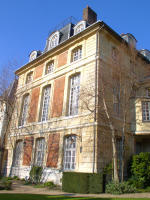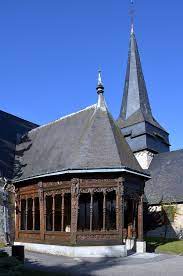Main residents in and around Rouen
-
From 1812 to 1818, before Gustave’s birth, the Flaubert parents lived in Rouen, 8, rue du Petit-Salut (now extinct), located between rue Grand-Pont and rue aux Ours.
-
From 1821 to 1846, the Flauberts lived at 51, rue de Lecat in Rouen. This house was located in the south wing of the Hotel Dieu, which was the official housing of the family. Flaubert was born there. This house still exists and now houses the Flaubert Museum and History of Medicine.
- In January 1846, on the death of Gustave Flaubert's father, the family had to leave and settled in Croisset, a commune of Canteleu, on the property purchased in 1844. She keeps a flat in Rouen.

Other residences in and around Rouen
-
1821-1844: Déville-lès-Rouen, 22, route de Dieppe: country house and family farm before the purchase of Croisset in 1844. Since 2005, building «Les Terrasses de Flaubert».
-
1846-1848: 55, avenue Gustave Flaubert, formerly 25, rue Crosne-hors-la-ville.
-
1848-1851: 8, rue de Le Nostre, formerly 6 bis, rue de Le Nostre.
-
1864-1871: 9a or 9 bis, quai du Havre, apartment occupied by Caroline, the niece, from her wedding.
-
1869-1878: 7c, quai du Havre, apartment occupied by Mrs.Flaubert mother, and preserved after her death in 1872.
Country house at Déville-les-Rouen
Places related to the family of Flaubert
Places in Seine-Inférieure (Seine-Maritime)
1828-1839: farm of Saint-Sulpice-la-Pierre, today commune of Saint-Maclou-de-Four.
1841-1846: Gruchy farm and mill in Montville-Anceaumeville.
Places in Calvados
1826-1874: farm of Beauregard and its meadows in Touques.
1829-1872: farm from Geffosses to Pont-l'Évêque.
1833-1872: parks and Parquets from Betteville to Pont-l'Évêque.
1837-1872: Thibout herbages in Angerville.
1837-1875: “Ferme du Coteau” in Deauville – Tourgeville, today Villa Strassburger
1837-1877: meadows from Royal-Pré to Criqueville.
In Paris
Three successive apartments where Flaubert stays a few months in the year:
- 1855-1869 : 42, boulevard du Temple
- 1869-1875 : 4, rue Murillo
- 1875-1879 : 240, rue du Faubourg-Saint-Honoré
Places of stay or passage attested by correspondence
- 1833-1841 : Les Andelys, 10 stays at Ernest Chevalier's house
- À partir de 1834 : Trouville sur Mer, 15 stays during summer.
- Vers 1836, 1841, 1853,1864, 1877 : Le Havre, 5 stays
- 1836 ou 1837 : Château du Héron, in Seine-Maritime near the Forêt de Lyons. Property of the Marquis of Pomereu at the time. This castle no longer exists, 1 stay.
- 1841, 1848 : La Neuville-Champ-d’Oisel [Chant-d’Oisel], 2 stays at Alfred Le Poittevin's house
- 1847, 1853, 1876, 1877 : Honfleur, 4 stays
- 1847, 1873, 1874 : La Bouille, 3 stays
- 1848 : Forges-les-Eaux [Forges-les-Bains], 1 stay.
- 1853, 1864, 1875 : Deauville, 3 stays
- 1860, 1864, 1878 : Étretat, 3 stays
- 1861-1878 : Ouville-la-Rivière, 8 stays with her niece Juliette Roquigny, daughter of her brother Achille
- 1866-1874 : Neuville-lès-Dieppe, 12 stays with her nice Caroline Commanville.
- 1876, 1877, 1879 : Le Vaudreuil, 3 stays at Edgar Raoul-Duval's house
- 1876 : Pont-l’Évêque, 1 stay
Places mentioned in his works
L’Éducation sentimentale : Le Havre.
Madame Bovary : Tôtes and surroundings [Tostes in the novel] : Rouen and la Seine-Maritime [Seine-Inférieure]. Yonville is an imaginary place. All other places are real.
See all names of places mentioned in the printed novel and in the drafts on the website "Flaubert" of the University of Rouen Normandie le site Internet "Flaubert" de l'Université de Rouen Normandie (relevé par Danielle Girard)
Un cœur simple : Pont-l’Évêque, Geffosses, Trouville, Honfleur.
Bouvard et Pécuchet
Dans le Calvados : Chavignolles is an imaginary place. All other places are real. Bayeux – Caen – Falaise – Honfleur- Balleroy – Barneville – Corbon – Coulibœuf – Courcy – Le Gast – Lisieux – Livarot – Pierre-au-Bordeu – Pierre-Couplée – Pierre-levée – Pont-L’Évêque – Torteval – Vallée d’Auge – Vallée de la Vire – Villers-sur-Mer – Villy – Vire. Autour de Caen : l’Abbaye d’Ardennes – Beaulieu –Colombiers-sur-Seulles – Courseulles – Hérouville – Langrune – Luc – N.-D. de La Délivrande – Ouistreham – Perriers – Tierceville. Au sud de Caen : Allemagne [Fleury] – Baron – Beaulieu – Bourguébus – Bretteville-le-Rabet – Bretteville-sur-Laize – Bully – Chichebouche – Curcy-sur-Orne – Évrecy – Feuguerolles – Fontenay-le-Marmion – Langannerie – Mézières – Mutrecy – Quilly – Tourville. Au nord de Falaise : la région de Chavignolles, Acqueville – Angoville – Bois Saint-Clair – Bonnœil – Bretteville-le-Rabet – Bretteville-sur-Laize – Cahan – Condé-sur-Noireau – Croisilles – Espins – La Aubrye [La Hauberie] – La Pommeraye – Lagannerie – Le Breuil – Leffard – Les Îles Bardel – Mesnil-Villement – Mont d’Éraines – Ouilly-le-Basset – Pierre-du-Post – Pierrepont – Potigny – Saint-Germain-Langot – Saint-Omer – Saint-Rémy – Tournebu – Ussy
Around Bayeux : Balleroy – Bayeux – Cartigny – Cottun – Escures – Fontenailles – Fosses de Soucy – Les Hachettes – Littry – Manoir d’Argouges – Manoir de Boissy – Marigny – Mont Phaunus – Noron-la-Poterie – Pont-Rû – Port-en-Bessin – Saint-Blaise – Sainte-Honorine-des-Pertes – Saint-Laurent-sur-Mer – Vaucelles
In the Orne Department : Argentan – Exmes – Alençon – Bons Moulins – Domfront – Fleuré – Gâtines-Saint-Hilaire – L’Aigle – Mortagne – Passais – Pierre du Jarrier – Pierre procureuse – Sainte-Gauburge – Sées.
In the Manche Department: Carentan – Chapelle-en-Juger – Cherbourg – Mortain – Saint-Lô.
In the Eure Department : Cocherel – Évreux – Nonancourt – Verneuil – Vexin
In the Seine-Maritime Department [Seine-Inférieure] : Bolbec – Cap de la Hève – Caudebec-les-Elbeuf – Dieppe – Elbeuf – Életot – Étretat – Fécamp – Forges-les-Eaux – Ingouville – Le Havre – Lillebonne – Mélamare – Montivilliers me – Monville – Orcher – Pissy – Rouen – Roumois
Source : Site Internet "Flaubert" de l'Université de Rouen Normandie
Ry, a place linked to the genesis of Madame Bovary

Flaubert knew the story of Eugene and Delphine Delamare, which took place in Ry. Eugène Delamare, a health officer and student of Achille-Cléophas Flaubert, born in 1812, was widowed after the death of his first wife. In 1839, he married Delphine Couturier, aged 17. She gave birth to a daughter, Alice, in 1842, and died in 1848 at the age of 26. Eugene, in turn, died in 1849 at the age of 37. The narrative of Madame Bovary and, with a few years, the chronology of the novel are recognizable. To reconstruct the history of the Delamare couple, we know of civil registration documents, an acknowledgement of debts towards the Flaubert parents, an inventory after Eugene’s death and his contributions to the deliberations of Ry’s municipal council and to the debates of the Republican Club of which he was one of the founders in 1848 (Eugène Delamare was more active than Charles!), but nothing, absolutely nothing about Delphine’s morals or the causes of her untimely death. We don’t know if she had any lovers or what causes her death.
On July 29, 1851, Maxime du Camp wrote to Flaubert: What do you do? What do you decide? What do you work? What do you write? Have you taken a side? Is it Don Juan? Is the story of Mrs. Delamare really beautiful?"
As soon as the novel was published in 1857, readers asked the author about the reality of history and places. Flaubert replied: No, sir, no model has ever been laid before me. Madame Bovary is a pure invention. But here in Normandy, we wanted to discover a host of allusions in my novel.”
The first part of the novel takes place in Tôtes. Vassonville, Saint-Victor, in the country of Caux oriental, are mentioned. Achille Cléophas Flaubert owned the Saint-Sulpice-la-Pierre farm near Vassonville. It may have inspired the description of the Bertaux farm, if however Flaubert went to the place, which is not attested by his letters.
Lyons-la-Forêt, location for film adaptations

With its half-timbered buildings, its halls of the thirteenth century and its green setting as frozen in time, Lyons-la-Forêt was chosen by two filmmakers of the twentieth century to adapt Madame Bovary.
In 1933, Jean Renoir was the first to come to shoot the novel in this village. It corresponds to the atmosphere of the novel and easily allows a reconstruction of the time.
In 1990, the city of Lyons-la-Forêt welcomed a new film crew: Claude Chabrol. Isabelle Huppert, Jean-François Balmer, Christophe Malavoix and Jean Yanne invest a Lyons decorated with new decors.
During the three months that the shooting will last, the 300 extras of the city have the opportunity to meet and sometimes make friends with the team of the film. It was based in the village, housed in hotels in the municipality and the surrounding area.
In 1991, in the Madame Bovary by Claude Chabrol, Lyons-la-Forêt and its surroundings served as scenery for the Agricultural Comics, filmed in the meadow of the Saint-Paul farm, and for the wedding dinner held at the Croix farm in Beauvoir-en-Lyons.
Sources : Site Internet "Flaubert" de l'Université de Rouen Normandie, Laboratoire CÉRÉDI, Daniel Fauvel et Hubert Hangard, Fortune et Infortune des Flaubert. Répertoire, Wooz éditions, 2018 ; Fortune et Infortune des Flaubert, tomes 1, 2, 3, Wooz éditions, 2019-2021.